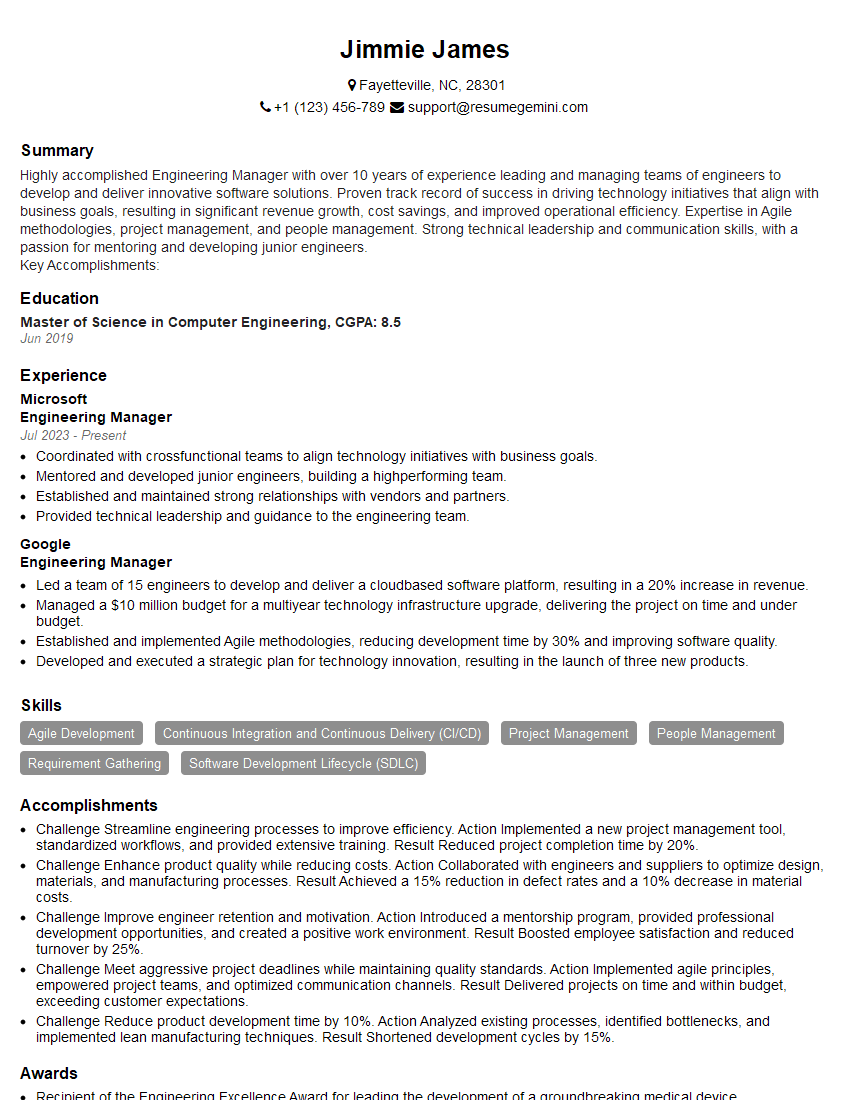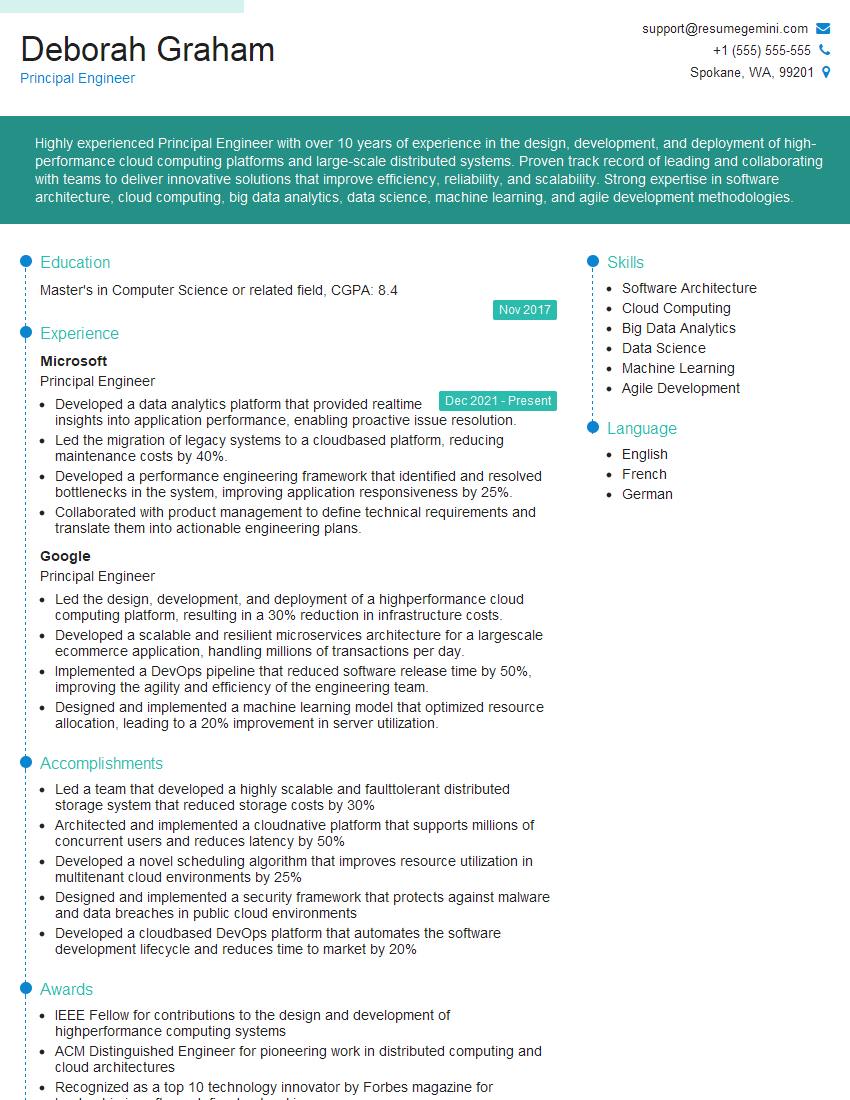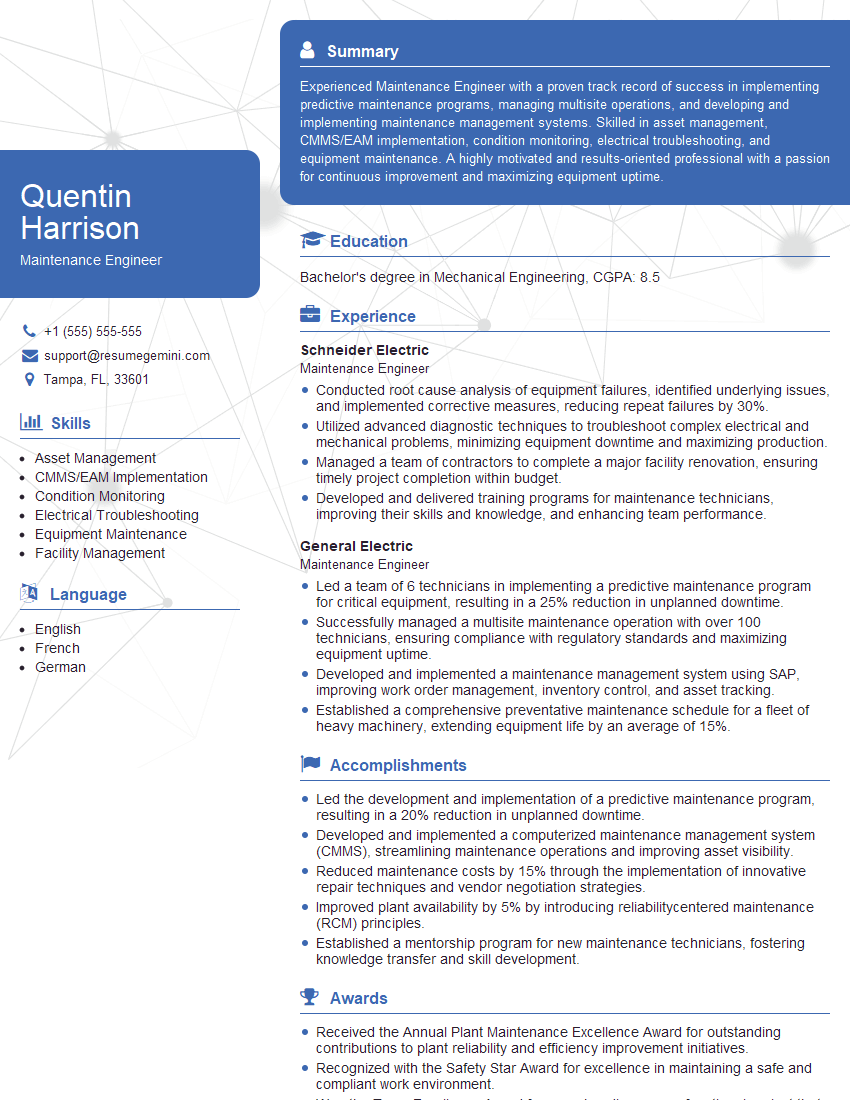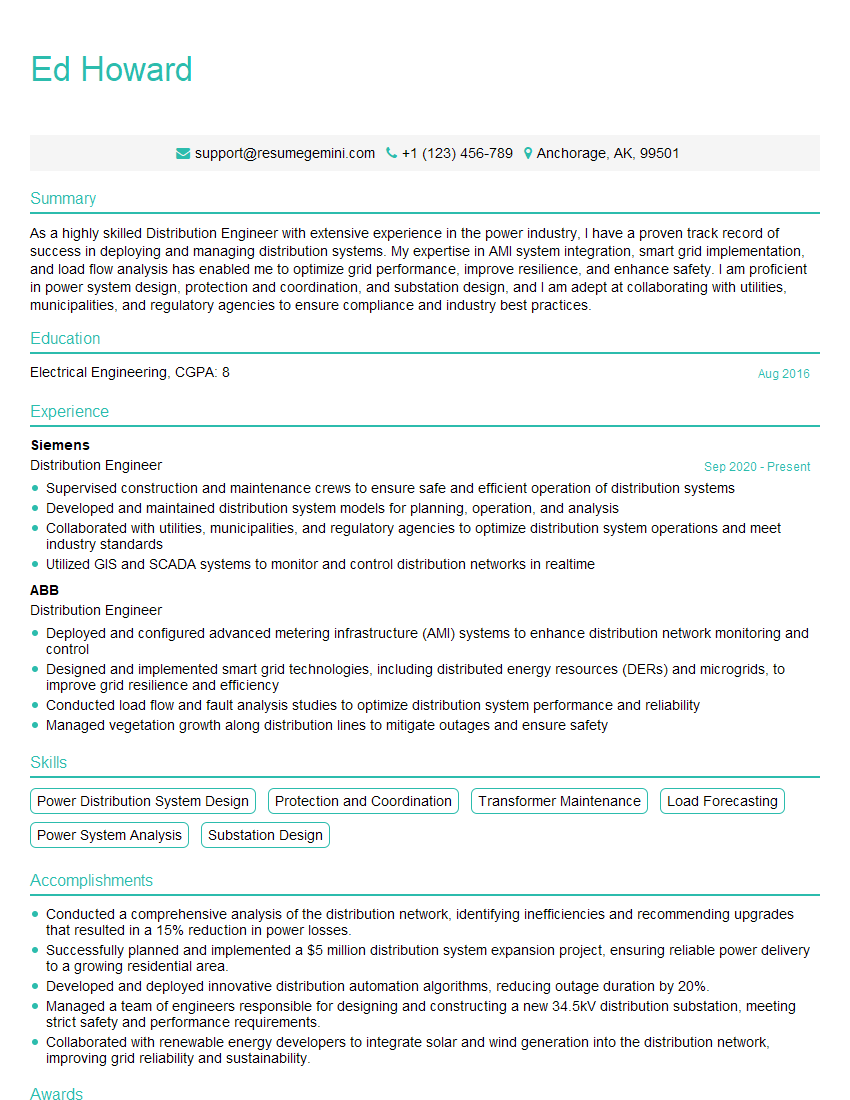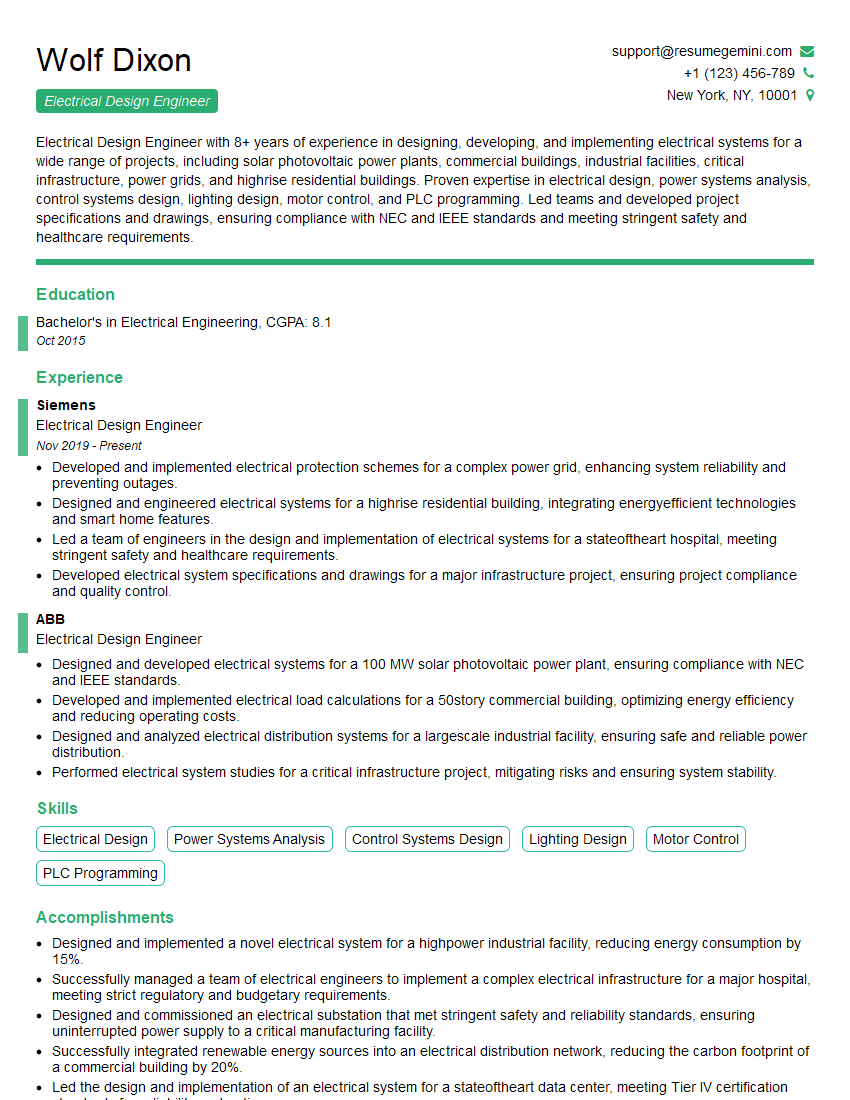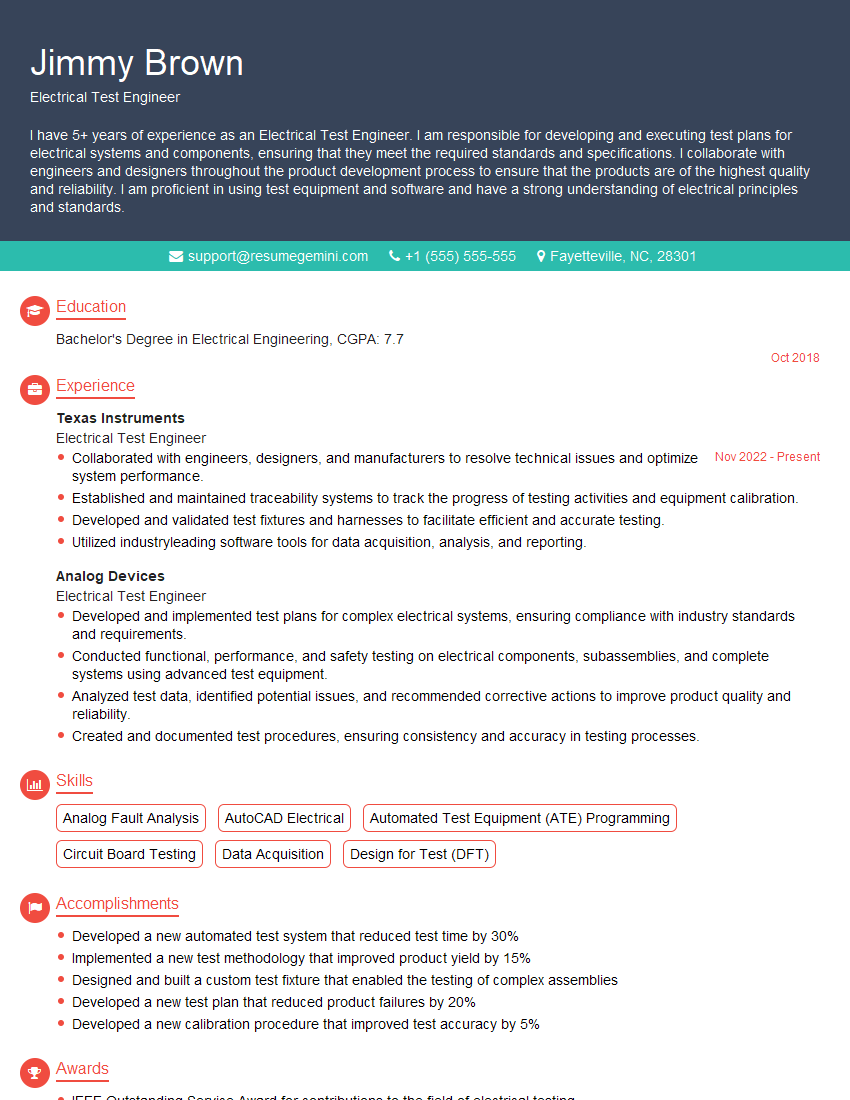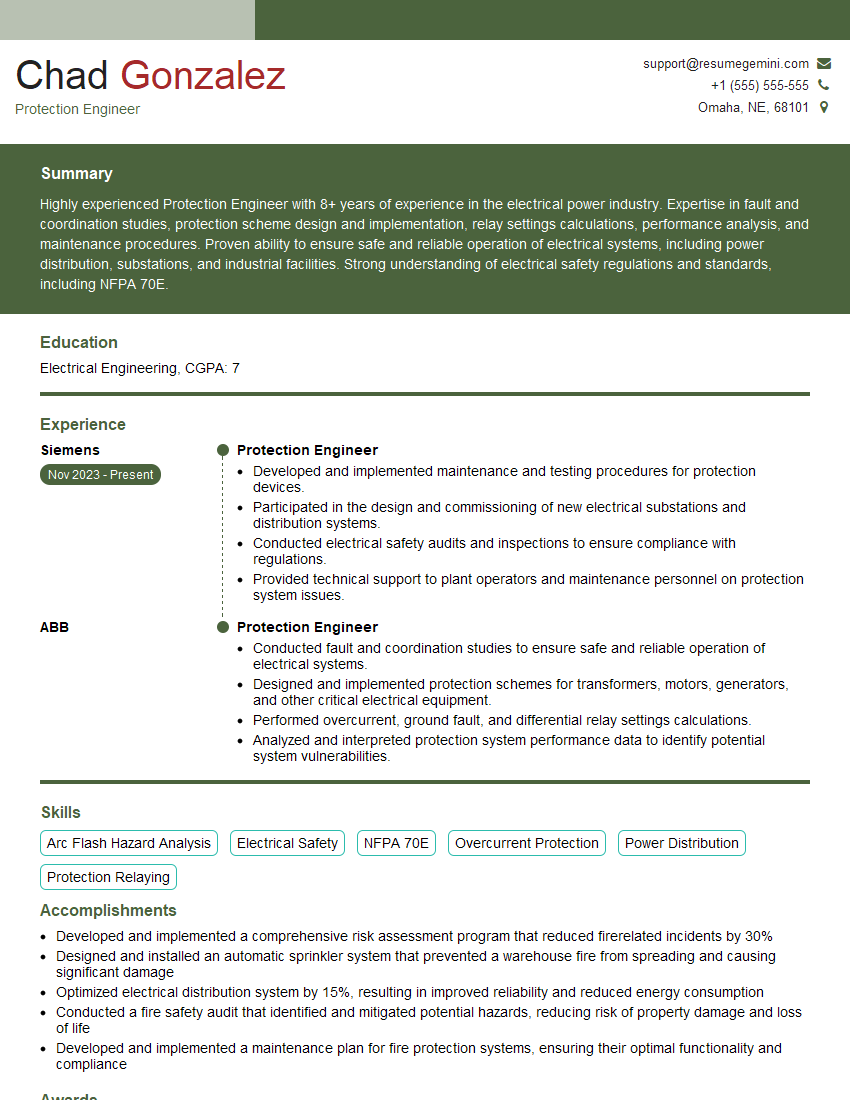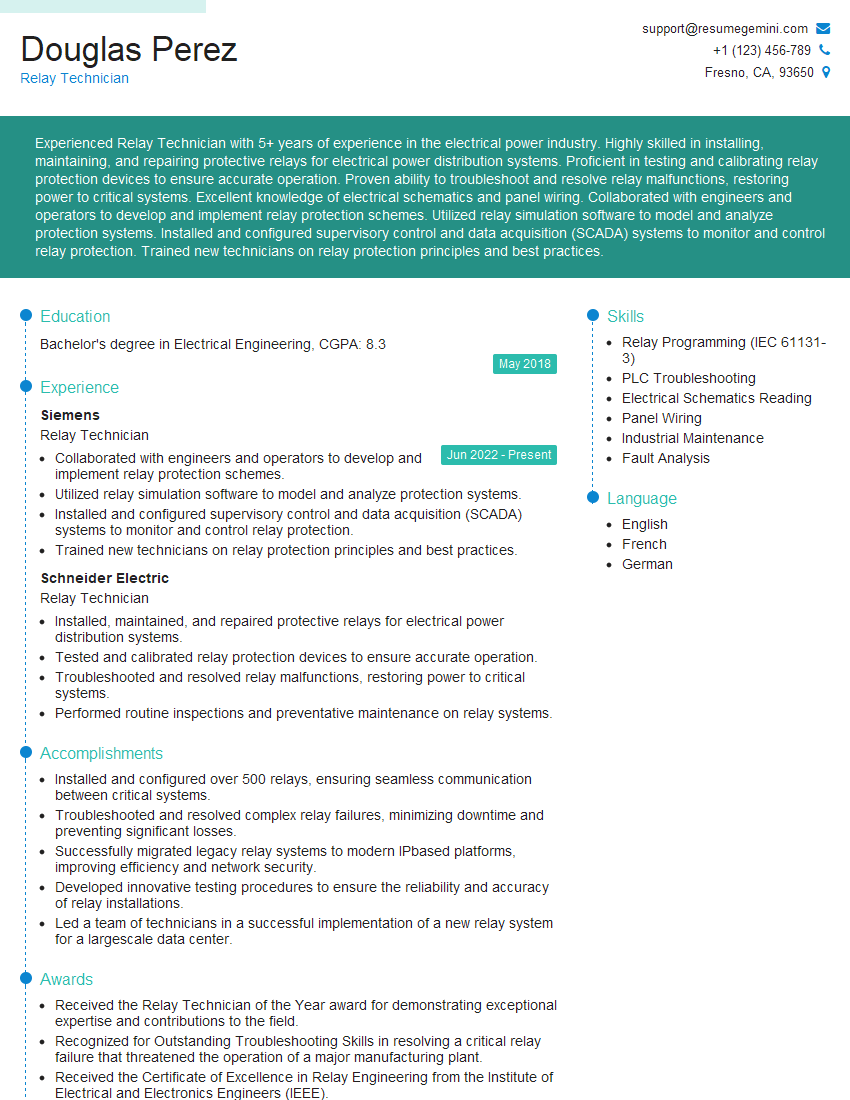Are you ready to stand out in your next interview? Understanding and preparing for ANSI/IEEE Std 315 interview questions is a game-changer. In this blog, we’ve compiled key questions and expert advice to help you showcase your skills with confidence and precision. Let’s get started on your journey to acing the interview.
Questions Asked in ANSI/IEEE Std 315 Interview
Q 1. Explain the purpose and scope of ANSI/IEEE Std 315.
ANSI/IEEE Std 315, officially titled “IEEE Standard Requirements for Instrument Transformers,” isn’t solely focused on protective relays. Its primary purpose is to define the requirements, testing procedures, and performance characteristics for instrument transformers (current transformers – CTs and potential transformers – PTs). These transformers are crucial components in protective relaying systems, as they provide the scaled-down current and voltage signals that relays use to sense faults. The standard’s scope, therefore, indirectly encompasses the accurate and reliable operation of protection systems that depend on the quality of these instrument transformers. Essentially, 315 ensures that the foundation upon which protective relaying is built is sound and dependable.
Imagine a building’s electrical system: the instrument transformers are like carefully calibrated measuring instruments. If these instruments are inaccurate, the entire safety and protection system (the protective relays) won’t work correctly, potentially leading to equipment damage or even hazards. ANSI/IEEE Std 315 makes sure these instruments are precise and reliable.
Q 2. Describe the different types of protective relays covered in ANSI/IEEE Std 315.
While ANSI/IEEE Std 315 doesn’t explicitly *list* types of protective relays, it’s integral to their proper function. The types of relays that rely heavily on the accuracy and performance of instrument transformers specified in 315 include:
- Overcurrent Relays: These relays detect faults by measuring the current flowing through a circuit. They depend on accurate CT ratios for reliable operation.
- Differential Relays: These relays compare currents entering and leaving a protected zone (like a transformer or generator). They rely on accurate CTs to precisely compare these currents.
- Distance Relays: These relays measure the impedance to a fault along a transmission line. They use both CTs and PTs to calculate the impedance, thus depending on the accuracy of both.
- Directional Relays: These relays determine the direction of fault current flow. They require accurate CTs and often use PTs to determine the phase angle of the current, relying on 315’s specifications.
Essentially, almost all types of protective relays indirectly fall under the purview of ANSI/IEEE Std 315 due to their dependence on accurately measured current and voltage signals provided by instrument transformers.
Q 3. What are the key differences between overcurrent and differential protection?
The key difference between overcurrent and differential protection lies in how they detect faults. Overcurrent protection is a simpler, less-precise method that detects faults based on the magnitude of current exceeding a preset threshold. Think of it like a simple circuit breaker – if the current gets too high, it trips. It’s effective for simple radial systems.
Differential protection, on the other hand, is much more sophisticated. It compares the currents entering and leaving a protected zone. In a fault-free condition, the currents are essentially equal. A significant difference signals an internal fault. This is analogous to a precise scale – any imbalance indicates a problem within the weighed object (the protected zone). It offers much better selectivity and sensitivity, being more accurate in identifying the location of the fault, preventing unnecessary tripping of healthy equipment.
For example, an overcurrent relay might trip for a fault on a nearby feeder, whereas a differential relay would only trip if the fault occurred within the zone it protects.
Q 4. Explain the operation of a distance relay.
A distance relay measures the impedance to a fault along a transmission line. It uses voltage and current measurements from PTs and CTs to calculate the apparent impedance. This impedance is compared to pre-set zones within the relay. If the calculated impedance falls within a zone, the relay operates, indicating a fault within that distance.
Imagine a transmission line as a long resistive wire. A fault will increase the impedance of the line. The distance relay acts like a sophisticated ohmmeter, measuring this change in impedance. Different zones represent different distances along the line. Zone 1 might cover the closest section of the line, while Zone 2 might extend further. This zoned approach allows for faster tripping closer to the fault and improved selectivity.
The formula used is simplified as Z = V/I where Z is impedance, V is voltage and I is current. The relay measures V and I from the PTs and CTs, respectively and compares Z to its preset zones.
Q 5. How does a pilot relay system work?
A pilot relay system uses communication channels between relays at either end of a protected transmission line to enhance the protection’s speed and selectivity. Instead of relying solely on local measurements, pilot relays exchange information about the fault. This allows for faster and more accurate fault location identification.
For instance, imagine two relays, one at each end of a long transmission line. If a fault occurs, each relay measures its local current and voltage. They then communicate this information to each other. By comparing these measurements, they can determine if a fault exists, its location and direction, enabling more effective and faster tripping than with a single local relay.
Communication methods can range from simple carrier-current communication (using the power line itself) to more sophisticated fiber optic or digital communication systems. This exchange of information allows for improved fault discrimination and faster clearing times, enhancing overall system stability and reliability.
Q 6. Describe the various communication methods used in protective relaying.
Several communication methods are used in protective relaying systems, each with advantages and disadvantages:
- Power Line Carrier (PLC): Uses the power line itself as a communication medium. It’s relatively inexpensive but susceptible to noise and limitations on bandwidth.
- Microwave Communication: Uses microwave signals for communication. Offers high bandwidth but requires line-of-sight transmission.
- Fiber Optic Communication: Offers high bandwidth, immunity to noise, and good security, making it a popular choice for modern systems, although the initial installation cost can be higher.
- Ethernet Communication: Increasingly used in modern substation automation systems and provides a standardized approach to relay communication. This allows for data integration and advanced functionality.
- Serial Communication: Older systems often use serial communication protocols (e.g., RS-232, RS-485). These protocols are simpler but have lower bandwidth than more modern options.
The choice of communication method depends on factors like distance, cost, required bandwidth, and environmental considerations.
Q 7. What are the different types of transformer protection schemes?
Several transformer protection schemes are employed, each designed to address different types of faults:
- Differential Protection: This is the most common and fundamental scheme. It compares the currents entering and leaving the transformer. Any significant difference indicates an internal fault.
- Overcurrent Protection: Provides backup protection in case the differential protection fails. It detects faults by measuring the current flowing through the transformer windings.
- Buchholz Relay Protection: Detects gas accumulation within the transformer tank, indicating an internal fault. This is a gas-pressure based system.
- Reflector Protection: A type of distance protection scheme suited for transformers, particularly with high impedance and high-capacity units. It helps pinpoint the location of an internal fault.
- Restricted Earth Fault Protection: Specifically targets earth faults within the transformer windings.
The choice of protection scheme depends on the transformer’s size, type, and application. Often, a combination of these schemes is used to provide comprehensive protection.
Q 8. Explain the principles of busbar protection.
Busbar protection is crucial for ensuring the reliable operation of a power system. Its primary goal is to quickly and selectively isolate faults occurring on the busbar itself, preventing cascading failures and minimizing damage. This is achieved through a combination of protective relays and current transformers (CTs).
The principles revolve around detecting abnormal currents or voltages indicative of a fault. For instance, a busbar fault will typically result in a significant increase in current flowing through the CTs connected to the busbar. These relays utilize various protection schemes, such as:
- Differential Protection: This is the most common and reliable method. It compares the currents entering and leaving the busbar. Under normal conditions, these currents should be nearly equal. A significant difference indicates a fault within the busbar zone.
- High-Set Overcurrent Protection: This serves as backup protection. It detects high currents exceeding a preset threshold, indicating a potential fault. However, this method is less selective than differential protection as it may not isolate the fault accurately.
- Busbar Earth Fault Protection: This is essential for detecting ground faults on the busbar, a common and potentially dangerous type of fault. It uses specialized relays sensitive to ground fault currents.
Imagine a large city’s power grid; the busbar is like the central distribution point. If a fault occurs at this critical point, a robust busbar protection system prevents a widespread blackout, ensuring the continued power supply to homes and businesses.
Q 9. How does a generator protection system work?
Generator protection is vital to safeguard generators from damage and ensure the stability of the power system. It involves various protection schemes working in concert, each targeting specific fault types.
A typical generator protection system includes:
- Overcurrent Protection: Protects against excessive currents caused by short circuits or overload conditions.
- Differential Protection: Compares currents entering and leaving the generator windings. A difference signals an internal fault within the generator.
- Loss of Excitation Protection: Detects the loss of excitation voltage, which can lead to generator instability and potential damage.
- Reverse Power Protection: Prevents power from flowing back into the generator from the system, a situation that can severely damage the machine.
- Over/Under Frequency Protection: Protects the generator from operating outside its safe frequency range.
- Over/Under Voltage Protection: Protects against voltage fluctuations that can damage the generator insulation.
Consider a large power plant. A fault within a generator could lead to a major power outage if not detected and cleared quickly. The protection system acts as a shield, automatically isolating the faulty generator and allowing other generators to continue supplying power.
Q 10. Describe the importance of coordination between protective relays.
Coordination between protective relays is paramount to ensure the selective tripping of faulty equipment without causing unnecessary outages. Each relay is responsible for a specific section of the power system, and proper coordination avoids cascading trips and minimizes disruption. This is achieved by carefully setting the operating characteristics of each relay such as their operating times and current settings.
Imagine a series of fuses in a circuit: each fuse protects a segment, and they’re sized to trip selectively—the closest fuse blows first, protecting the rest of the circuit. Similarly, relays are set to ensure the faulty element is isolated without affecting the rest of the system. Poor coordination can lead to unnecessary trips of healthy equipment, disrupting power supply to numerous customers and causing financial losses.
Coordination typically involves creating time-current curves for each relay, ensuring that the relays closest to the fault operate first, and the relays further away operate sequentially with sufficient time delay to allow the closest relays to operate before they are activated.
Q 11. What are the common settings for an overcurrent relay?
Common settings for an overcurrent relay include:
- Pick-up Current (Ipickup): The minimum current required to initiate the relay operation. It’s set slightly above the maximum normal load current to avoid nuisance tripping.
- Time Setting (TMS): The time delay before the relay trips after the current exceeds the pickup current. This is crucial for coordination with other relays.
- Time-Current Characteristic Curve: Defines the relationship between the fault current magnitude and the tripping time. Different curves (e.g., inverse, extremely inverse) offer varying degrees of sensitivity and selectivity.
- Instantaneous Overcurrent Element: Many overcurrent relays include an instantaneous element that trips immediately if the current exceeds a very high threshold. This element offers rapid fault clearance for severe faults.
For example, an overcurrent relay protecting a feeder might have a pickup current of 200 amps and a time dial setting resulting in 0.5 second trip time at 400 amps, 1 second at 300 amps. The instantaneous setting might be 1000 amps for rapid tripping for extreme short-circuit currents.
Q 12. Explain the concept of time-current characteristic curves.
Time-current characteristic curves are graphical representations of a relay’s operating time versus the fault current magnitude. They are essential for relay coordination. These curves help determine how quickly a relay will operate depending on the fault current level.
Different curves exist, each representing a different relay operating characteristic:
- Inverse Curve: The tripping time decreases inversely with the fault current magnitude. It’s suitable for applications where faster tripping is preferred for larger faults.
- Very Inverse Curve: Provides faster tripping than an inverse curve for high fault currents.
- Extremely Inverse Curve: Offers the fastest tripping for very high currents, usually used for backup protection.
- Definite Time Curve: The tripping time remains constant regardless of the fault current magnitude. This is often used for backup protection where speed is not as critical.
Imagine a graph where the x-axis represents fault current and the y-axis represents trip time. The curves visually show how the relay responds to different fault levels, allowing for easy coordination with other relays protecting the same system. By analyzing these curves, engineers ensure that the right relays trip at the right time.
Q 13. What are the different types of fault calculations used in relay settings?
Fault calculations are fundamental to setting protective relays accurately. They help determine the expected fault currents and voltages at various points in the power system. This information is crucial for determining appropriate relay settings to ensure selectivity and reliability. Common methods include:
- Symmetrical Component Analysis: A powerful technique for analyzing unbalanced fault conditions (e.g., single-line-to-ground faults, line-to-line faults). It decomposes the fault currents into symmetrical components (positive, negative, zero sequence) to simplify the analysis.
- Z-Bus Matrix Method: A method used for calculating bus voltages and currents in large power systems under various fault conditions. It’s particularly useful for large interconnected networks.
- Simplified Methods: For simpler systems, approximations such as using per-unit calculations and simplified equivalent circuits can be used to estimate fault currents.
Accurate fault calculations are essential to avoid cascading failures. For instance, if a relay is set incorrectly and fails to trip during a fault, it could lead to further damage and potential loss of power. Software tools are often used to perform these complex calculations.
Q 14. Describe the role of impedance in relay settings.
Impedance plays a crucial role in relay settings, especially for distance relays. Distance relays measure the impedance between the relay location and the fault point. By comparing the measured impedance to predefined zones, the relay determines the location of the fault.
The impedance seen by a distance relay is a function of the system impedance and the fault impedance. Relay settings are based on the impedance values expected under various fault conditions. Accurate impedance calculation is crucial for proper relay operation. Incorrect settings can lead to relay malfunction and failures to clear faults.
For example, a distance relay might have three zones: Zone 1, with a short reach, protecting the closest section of the line; Zone 2, a longer reach; and Zone 3, a much longer reach that acts as a backup. Each zone has a specific impedance setting defining its reach. Understanding the system impedance and its variations (depending on load changes and system configuration) is key to setting up these zones correctly, ensuring reliable and selective fault clearance.
Q 15. How do you test and maintain protective relays?
Testing and maintaining protective relays is crucial for ensuring the reliable and safe operation of power systems. It involves a multi-stage process combining routine checks, periodic testing, and comprehensive maintenance.
Routine Checks: These include visual inspections for loose connections, damage to components, and verifying proper communication with the system. Think of it like a regular car check-up – you spot minor issues before they become major problems.
Periodic Testing: This involves using specialized test equipment to simulate faults and verify the relay’s response. We use different types of test sets – some are simple, others very sophisticated, depending on the relay type and system complexity. For example, we might inject current to simulate a fault and confirm the relay operates correctly and within its defined settings. This is similar to an emissions test for a car, ensuring it’s performing within the expected parameters.
Comprehensive Maintenance: This includes tasks like cleaning contacts, replacing aging components, and performing firmware updates. This is akin to a major car service – addressing wear and tear and ensuring optimal functionality.
The frequency of these checks and tests depends on the criticality of the protected equipment and the relay’s type. Critical relays in power plants might be tested more frequently than those in a less critical distribution substation.
Career Expert Tips:
- Ace those interviews! Prepare effectively by reviewing the Top 50 Most Common Interview Questions on ResumeGemini.
- Navigate your job search with confidence! Explore a wide range of Career Tips on ResumeGemini. Learn about common challenges and recommendations to overcome them.
- Craft the perfect resume! Master the Art of Resume Writing with ResumeGemini’s guide. Showcase your unique qualifications and achievements effectively.
- Don’t miss out on holiday savings! Build your dream resume with ResumeGemini’s ATS optimized templates.
Q 16. Explain the importance of grounding in power systems protection.
Grounding in power systems protection is absolutely essential for several reasons. It provides a low-impedance path for fault currents, ensuring that they are diverted safely to the earth and protecting equipment and personnel.
Fault Current Limiting: Grounding allows fault currents to flow to earth, limiting their magnitude and duration. This helps prevent excessive damage to equipment and minimizes the risk of fire.
Personnel Safety: By rapidly clearing faults, grounding reduces the risk of electric shock to personnel working near or on the equipment.
Equipment Protection: Grounding prevents voltage surges and overvoltages that can damage sensitive electronic components within the equipment.
Relay Operation: Many protective relays rely on ground fault detection to function correctly. Without a good ground, these relays might not operate as intended, leading to potential equipment damage or system instability.
Imagine a building with faulty wiring. A proper grounding system prevents dangerous voltage buildup, protecting both people and equipment from potentially lethal electric shock. In a power system, grounding plays the same crucial role.
Q 17. What are the safety considerations when working with protective relays?
Safety when working with protective relays is paramount. High voltages and potentially lethal currents are present, demanding strict adherence to safety procedures.
Lockout/Tagout Procedures: Before any work on protective relays or the associated equipment, a strict lockout/tagout procedure must be followed to isolate the power completely. This ensures that no unexpected power can be applied while working on the system.
Personal Protective Equipment (PPE): Appropriate PPE, including insulated gloves, safety glasses, and arc flash clothing, should be worn at all times. It’s crucial to remember that safety equipment is the first line of defense.
Training and Competency: Only trained and authorized personnel should work on protective relays. A thorough understanding of the system, relay operation, and safety procedures is vital.
Voltage Verification: Always verify that the equipment is de-energized before commencing any work. Using a reliable voltage tester is essential.
Ignoring these safety measures can lead to severe injuries or even fatalities. Safety should be the top priority in all aspects of working with protective relay systems.
Q 18. What are the challenges in applying protective relaying to renewable energy systems?
Applying protective relaying to renewable energy systems presents unique challenges. The intermittent and distributed nature of these resources, coupled with their often complex characteristics, demands novel solutions.
Intermittency and Variability: The fluctuating nature of renewable generation (solar and wind) can impact fault detection and coordination. Relays need to be adjusted to handle these variable conditions.
Distributed Generation: The distributed nature of renewable energy sources makes it difficult to effectively coordinate protection schemes across a wider geographical area. Communication delays can hinder relay operation.
Fault Characteristics: Faults in renewable systems might have different characteristics than traditional power systems, requiring specialized protection schemes.
Protection Coordination: Integrating renewable generation with traditional grids requires careful coordination of protection schemes to prevent cascading outages.
For example, a sudden drop in wind power generation might be misinterpreted by a relay as a fault if not properly accounted for. Advanced relay technologies and communication protocols are necessary to address these challenges effectively.
Q 19. Explain the impact of fault current limiters on relay settings.
Fault current limiters (FCLs) significantly impact relay settings. These devices reduce the magnitude of fault currents, potentially affecting the operation of relays designed for higher fault levels.
If a relay is set for a fault current level that is higher than what the FCL allows, it may not operate as expected. For instance, an overcurrent relay might not trip if the fault current is reduced below its pick-up setting by the FCL. This requires careful coordination between the FCL’s performance characteristics and the relay settings.
Therefore, relay settings need to be adjusted to account for the presence of FCLs. This adjustment might involve lowering the relay’s current settings or modifying the time-current characteristics. This careful calibration ensures the protection system remains effective while incorporating the benefits of the FCL in limiting fault currents.
Q 20. How do you troubleshoot a malfunctioning protective relay?
Troubleshooting a malfunctioning protective relay involves a systematic approach. It starts with gathering information and proceeds with testing and verification.
Gather Information: Begin by collecting data on the malfunction – the time of occurrence, the type of fault, and any associated events. Look at event logs and fault recordings.
Visual Inspection: Examine the relay for any obvious signs of damage, loose connections, or unusual indications.
Testing: Use test equipment to verify the relay’s functionality and settings. Verify communication with other equipment.
Firmware and Configuration: Check for software errors, outdated firmware, or incorrect settings in the relay’s configuration.
Calibration: Sometimes the problem might be a drift in the relay’s calibration over time. Recalibration might be needed.
Imagine it like diagnosing a car problem. You start by observing the symptoms, then systematically check various components until you locate the source of the malfunction. The same methodical approach is vital for troubleshooting protective relays.
Q 21. What are the latest advancements in protective relay technology?
Protective relay technology is constantly evolving. Recent advancements include improved communication capabilities, enhanced numerical algorithms, and greater integration with broader systems.
Improved Communication: Modern relays utilize advanced communication protocols (like IEC 61850) to allow for faster and more efficient data exchange between relays and control centers. This facilitates quicker fault detection and response.
Advanced Numerical Algorithms: New algorithms allow for more accurate fault detection and discrimination, enabling faster clearing times and improved system stability.
Increased Integration: Relays are increasingly integrated with other systems like SCADA (Supervisory Control and Data Acquisition) and energy management systems, allowing for better situational awareness and more comprehensive system monitoring.
Phasor Measurement Units (PMUs): PMUs provide high-resolution synchronized measurements of voltage and current phasors, significantly improving the accuracy and speed of fault location and system analysis.
These advancements are leading to more reliable, efficient, and resilient power systems, capable of handling the increasing complexity and demands of modern energy grids.
Q 22. Discuss the use of digital relays versus electromechanical relays.
The shift from electromechanical to digital relays in power system protection represents a significant technological leap. Electromechanical relays, based on electromagnetic principles, are simple and reliable but have limitations in functionality and flexibility. They operate based on predefined thresholds and time delays, offering only a limited set of protection functions. Think of them like old-fashioned light switches – they either turn on or off based on a simple voltage or current threshold.
Digital relays, on the other hand, utilize microprocessors to perform complex calculations and implement advanced protection algorithms. They offer a far wider range of protection functions, including distance protection, differential protection, and various types of overcurrent protection, all configurable and adaptable to various system needs. They are analogous to a smart thermostat that learns your preferences and optimizes energy usage. They offer features like self-diagnosis, data logging, and communication capabilities, significantly enhancing system monitoring and analysis. This flexibility allows for customized protection schemes tailored to specific system requirements and improved overall system reliability and efficiency.
For example, a digital relay can be easily reconfigured remotely to accommodate system upgrades or changes in operating conditions, while a change to an electromechanical relay would require on-site intervention and potential downtime. This flexibility is crucial in modern power systems that are increasingly complex and dynamic.
Q 23. Describe the role of communication protocols in modern protective relaying systems.
Communication protocols are essential in modern protective relaying systems, enabling seamless data exchange between relays, substations, and control centers. They facilitate remote monitoring, control, and automated actions. Popular protocols include IEC 61850, which defines a standardized framework for communication within substations, and DNP3, another widely used protocol for utility applications. These protocols allow relays to communicate measurements, status information, and trip commands, enhancing situational awareness and enabling faster response times to faults.
Imagine a scenario where a fault occurs on a transmission line. With communication protocols in place, the protective relay at the faulted section can instantly transmit fault information to the control center, potentially enabling faster isolation of the fault and minimizing the impact on the power system. Furthermore, protocols allow for remote configuration and testing of relays, reducing the need for on-site visits and saving time and resources.
IEC 61850, for instance, enables intelligent electronic devices (IEDs) within the substation to communicate using a common language. This significantly improves interoperability and reduces integration complexities. Different vendors’ equipment can readily integrate, making system expansion and maintenance easier.
Q 24. Explain the concept of cyber security in the context of protective relaying.
Cybersecurity in protective relaying is paramount because a compromised relay can have catastrophic consequences, potentially leading to widespread blackouts or significant damage to equipment. Relays are becoming increasingly interconnected, making them vulnerable to cyberattacks. Threats include unauthorized access, data manipulation, and denial-of-service attacks. These attacks can disrupt relay operation, preventing them from detecting and clearing faults or even triggering false trips, causing unnecessary outages.
To mitigate these risks, robust cybersecurity measures are crucial. These include network segmentation to isolate relay networks from other corporate networks, access control mechanisms to limit access to authorized personnel only, encryption of communication channels to protect data confidentiality, and intrusion detection and prevention systems to monitor network traffic for suspicious activity. Regular security audits and penetration testing are essential to identify vulnerabilities and implement necessary countermeasures. Strong password policies and firmware updates are also critical components of a comprehensive security strategy. Think of it as the equivalent of a security system for your home – multiple layers of protection are needed to safeguard against intrusions.
For example, a denial-of-service attack could overload a relay’s communication channels, preventing it from sending trip commands, leading to prolonged outages. Regular vulnerability assessments and security updates are therefore crucial to maintain the integrity and reliability of the power system.
Q 25. How does ANSI/IEEE Std 315 relate to other relevant standards?
ANSI/IEEE Std 315, which covers the requirements for protective relaying equipment, is closely related to other standards that define aspects of power system operation and safety. For example, it works in conjunction with IEC 61850, providing the communication protocol framework for the equipment specified by 315. IEEE C37 series standards define specific relay performance requirements and testing methods for various protection functions, complementing the broader requirements laid out in ANSI/IEEE Std 315.
Furthermore, standards related to power system design, like those defining substation design, equipment grounding, and overall system protection schemes, directly influence how protective relaying equipment is specified and integrated. These interrelationships ensure a holistic and consistent approach to power system safety and reliability. Imagine building a house – ANSI/IEEE Std 315 defines the electrical components, IEC 61850 dictates how they communicate, while other standards cover structural and safety aspects. The coordination of all these aspects is vital for a safe and functional building (power system).
Q 26. What is the significance of protective relay settings in system stability?
Protective relay settings play a critical role in system stability. Incorrect settings can lead to cascading outages and widespread instability. The speed and selectivity of relay operation are essential in isolating faults quickly and preventing them from propagating to other parts of the system. Relays that are too slow to operate might allow faults to grow, leading to system instability. Conversely, relays that are too fast or insensitive might cause unnecessary tripping, leading to system instability and potentially cascading failures.
For example, improperly set overcurrent relays can fail to trip during a fault, resulting in excessive current flow and damage to equipment. Conversely, relays set too sensitively might trip during normal operating conditions, causing unnecessary outages. Careful coordination of relay settings, considering the characteristics of the power system and equipment, is essential to ensure reliable protection and maintain system stability. This involves understanding fault currents, impedance characteristics, and the coordination of protection schemes across the entire system. Specialized software tools are often used for relay coordination studies to determine optimal settings.
Q 27. Describe a scenario where a protective relay malfunctioned and its consequences.
Imagine a scenario where a distance relay on a transmission line malfunctions due to a software bug. Instead of tripping only for faults within its zone of protection, the relay falsely trips during a normal operating condition. This leads to an unnecessary outage of a significant portion of the power system. The consequence would be a disruption of electricity supply to consumers, financial losses due to production downtime, and potential damage to equipment from sudden power interruptions. In extreme cases, such a malfunction can trigger a wider cascade of events, leading to a larger blackout.
Another example involves a failure in the communication interface of a protective relay. If this interface fails, the relay might not be able to communicate fault information to the control center, delaying the response time to the fault and increasing the potential damage to the system. Regular testing, maintenance, and cybersecurity measures are crucial in preventing such scenarios and mitigating the consequences.
Q 28. How do you ensure the proper coordination of protection schemes in a complex power system?
Ensuring proper coordination of protection schemes in a complex power system requires a systematic approach. This involves analyzing the system’s electrical characteristics, including fault currents, impedances, and relay operating times. Specialized software tools are frequently employed to simulate different fault scenarios and verify the proper operation of the protection system. This process, known as relay coordination studies, is crucial for ensuring that the relays operate selectively and in the correct sequence to isolate faults quickly and efficiently without causing unnecessary outages.
The coordination process involves determining the proper settings for each relay to ensure that: (1) The correct relay trips for a fault within its protected zone; (2) The relays operate in a defined sequence, preventing cascading trips; and (3) The system is protected against various types of faults, such as short circuits, ground faults, and overloads. This coordination needs to account for the various protection schemes implemented within the power system, including overcurrent, differential, and distance protection schemes.
The process requires a deep understanding of protection principles, power system analysis techniques, and the use of specialized software tools. Thorough testing and verification are essential to ensure the effectiveness of the coordinated protection system.
Key Topics to Learn for ANSI/IEEE Std 315 Interview
Preparing for an ANSI/IEEE Std 315 interview requires a thorough understanding of its core principles and practical applications. This standard is crucial for professionals in electrical power systems, and showcasing your knowledge will significantly boost your interview prospects. Focus your studies on these key areas:
- Insulation Coordination: Understand the fundamental principles of insulation coordination, including basic insulation levels (BIL), withstand voltage, and impulse testing. Explore the practical application of these concepts in protecting electrical equipment from overvoltages.
- Lightning Protection: Master the methods for protecting electrical systems from lightning strikes. This includes understanding surge arresters, grounding systems, and the role of ANSI/IEEE Std 315 in specifying protection levels. Be prepared to discuss case studies or scenarios where lightning protection is critical.
- Switching Surges: Learn about the generation and impact of switching surges on power systems. Understand how ANSI/IEEE Std 315 guides the selection and application of equipment designed to withstand these surges. Be ready to discuss mitigation strategies.
- Overvoltage Protection Devices: Develop a strong understanding of various overvoltage protection devices, their characteristics, and applications. This includes metal-oxide varistors (MOVs), surge arresters, and gas-filled tubes. Be prepared to compare and contrast different technologies.
- Testing and Measurement Techniques: Familiarize yourself with the testing procedures and measurement techniques used to evaluate the insulation performance of electrical equipment in accordance with ANSI/IEEE Std 315. This includes both laboratory and field testing methods.
- Standard Interpretation and Application: Focus on understanding the practical application of the standard itself. Be ready to discuss how specific clauses relate to real-world scenarios and problem-solving.
Next Steps
Mastering ANSI/IEEE Std 315 demonstrates a commitment to safety and expertise in power systems engineering, significantly enhancing your career prospects. A well-crafted resume is your first impression; make it count! Creating an ATS-friendly resume increases your chances of getting your application noticed. To help you build a professional and impactful resume that showcases your ANSI/IEEE Std 315 knowledge, we recommend using ResumeGemini. ResumeGemini provides tools and resources to build a strong resume, and we even provide examples of resumes tailored to ANSI/IEEE Std 315 roles. Take the next step towards your dream job today!
Explore more articles
Users Rating of Our Blogs
Share Your Experience
We value your feedback! Please rate our content and share your thoughts (optional).
What Readers Say About Our Blog
Hello,
We found issues with your domain’s email setup that may be sending your messages to spam or blocking them completely. InboxShield Mini shows you how to fix it in minutes — no tech skills required.
Scan your domain now for details: https://inboxshield-mini.com/
— Adam @ InboxShield Mini
Reply STOP to unsubscribe
Hi, are you owner of interviewgemini.com? What if I told you I could help you find extra time in your schedule, reconnect with leads you didn’t even realize you missed, and bring in more “I want to work with you” conversations, without increasing your ad spend or hiring a full-time employee?
All with a flexible, budget-friendly service that could easily pay for itself. Sounds good?
Would it be nice to jump on a quick 10-minute call so I can show you exactly how we make this work?
Best,
Hapei
Marketing Director
Hey, I know you’re the owner of interviewgemini.com. I’ll be quick.
Fundraising for your business is tough and time-consuming. We make it easier by guaranteeing two private investor meetings each month, for six months. No demos, no pitch events – just direct introductions to active investors matched to your startup.
If youR17;re raising, this could help you build real momentum. Want me to send more info?
Hi, I represent an SEO company that specialises in getting you AI citations and higher rankings on Google. I’d like to offer you a 100% free SEO audit for your website. Would you be interested?
Hi, I represent an SEO company that specialises in getting you AI citations and higher rankings on Google. I’d like to offer you a 100% free SEO audit for your website. Would you be interested?
good
